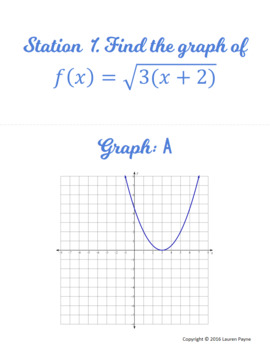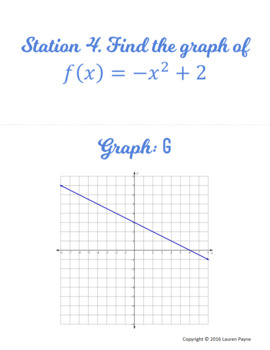Graphing Parent Functions & Transformations Scavenger Hunt
Lauren Payne
52 Followers
Grade Levels
8th - 12th, Higher Education
Subjects
Resource Type
Standards
CCSSHSF-BF.B.3
Formats Included
- PDF
Pages
33 pages
Lauren Payne
52 Followers
What educators are saying
My students loved that this was not a regular worksheet. They enjoyed getting up and moving around the room. All students were engaged and trying their best!
Description
Graphing Parent Functions & Transformations Scavenger Hunt
This walk around activity will help students practice identifying and transforming parent functions based on the function's equation. Students begin the activity by choosing any one of the equations posted around the classroom, and the graph of that equation will lead them to the next station.
This scavenger hunt requires students to be familiar with the constant, linear, quadratic, cubic, square root, absolute value, and reciprocal parent functions. Students should be able to identify and describe transformations based on the function's equation. Transformations include vertical and horizontal dilations, vertical and horizontal translations, and reflections across the x-axis.
This download includes a 14 station scavenger hunt (provided in color and grayscale), instructions, a student response sheet, and an answer key.
Please follow my store to be notified when new products are available and feel free to message me with any questions or comments that you have.
This walk around activity will help students practice identifying and transforming parent functions based on the function's equation. Students begin the activity by choosing any one of the equations posted around the classroom, and the graph of that equation will lead them to the next station.
This scavenger hunt requires students to be familiar with the constant, linear, quadratic, cubic, square root, absolute value, and reciprocal parent functions. Students should be able to identify and describe transformations based on the function's equation. Transformations include vertical and horizontal dilations, vertical and horizontal translations, and reflections across the x-axis.
This download includes a 14 station scavenger hunt (provided in color and grayscale), instructions, a student response sheet, and an answer key.
Please follow my store to be notified when new products are available and feel free to message me with any questions or comments that you have.
Total Pages
33 pages
Answer Key
Included
Teaching Duration
N/A
Report this resource to TPT
Reported resources will be reviewed by our team. Report this resource to let us know if this resource violates TPT’s content guidelines.
Standards
to see state-specific standards (only available in the US).
CCSSHSF-BF.B.3
Identify the effect on the graph of replacing 𝘧(𝘹) by 𝘧(𝘹) + 𝘬, 𝘬 𝘧(𝘹), 𝘧(𝘬𝘹), and 𝘧(𝘹 + 𝘬) for specific values of 𝘬 (both positive and negative); find the value of 𝘬 given the graphs. Experiment with cases and illustrate an explanation of the effects on the graph using technology.





